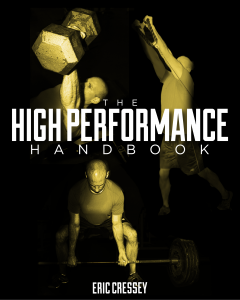
Strength Training Programs: How Many Sets and Reps? – Part 2
In today’s post, we’ve got the second half of a Q&A response regarding how to determine the optimal number of sets and reps for strength exercises. In case you missed the first installment, be sure to check out Strength Training Programs: How Many Sets and Reps – Part 1. We pick up with factors 7-13:
7. Whether You’re Trying to Correct Muscle Imbalances – In Part 1 (Bulletpoint 4) of my five-part Correcting Bad Posture series, I talked about how I like to use a 2:1 pull-to-pushing ratio with those who have significant upper body muscle imbalances. In addition to upping the sets, you can also use higher rep schemes. So, something like this would be an easy way to accumulate more volume:
A1) Chest-Supported Row – Neutral Grip: 4×8
A2) Low Incline Barbell Press: 3×6
Effectively, you’re not only getting more total sets in favor of “postural balance;” you’re also getting more reps per set.
8. How Neurally Efficient a Client/Athlete Is – Some athletes – especially those who tend to be of a more slow-twitch muscle fiber predominance – always seem to need to get more sets in on their strength exercises. This is impacted in a lot of them by a previous history of endurance training – whether it’s high school soccer or a dedicated running career – that made them less efficient at tapping in to high threshold motor units. The same holds true for female athletes; they always seem to need a little extra volume on strength exercises; it’s almost as if they can’t ramp up to a max as quickly as men. I don’t think you necessarily need to increase reps per set, but definitely ought to consider adding an additional set or two.
9. Whether You’re Trying to Achieve a Metabolic Training Benefit – Some programs use a concept called metabolic resistance training to improve cardiovascular conditioning and increase energy expenditure so that you can burn fat faster. Generally, in programs like these, you’ll need more sets and higher reps to elicit this training effect.
10. Whether You’re Dealing with a Post-Injury Client – In these folks, you want to keep the sets and reps down and gradually ease them back in to things. So, while a “normal” client might be fluctuating up and down to impose and decrease training stress, respectively, an post-injury client would be gradually increasing the sets and reps to match his/her capacity for loading at a particular time.
That said, you have to be cognizant of giving them sufficient volume to maintain a training effect and keep them from going insane. So, using the example of someone with shoulder pain, you might have to cut back on pressing movements, but you can really bump up the volume on horizontal pulling sets and reps.
11. What Else You’re Doing – The base mesocycle of the Smolov Squat Program goes like this:
Monday: 4×9
Wednesday: 5×7
Friday: 7×5
Saturday: 10×3
Sure, this is a ton of work (and very specific work at that), but quite a few lifters have used it with excellent success. You know what, though? Try adding a lot of extra sets and reps for “other stuff” and you’ll fail…miserably. You can’t specialize on everything all at once. If sets and reps go up in one facet of your strength and conditioning program, they have to come down somewhere else.
12. Whether Soreness is of Concern – With our in-season athletes, we want to avoid soreness at all costs. The easiest way to do this is to avoid changing strength exercises, but this isn’t really feasible, as most athletes will get sick and tired of doing the same thing over and over again all season. So, we need to be careful about strategically substituting new strength exercises during in-season training. One way to make it go smoothly is to simply keep the sets and reps down in the first round through a new training program. Let’s say that we were doing front squats in-season. We’d probably go something like this:
Week 1: 1×3 reps
Week 2: 3×3 reps
Week 3: 3×3 reps
Week 4: 2×3 reps (deload)
This leads me to my final point…
13. Whether or Not an Athlete is In-Season – If an athlete is in-season, less is more. I prefer to have our athletes leave the gym feeling refreshed after their in-season training sessions – so they might be completely finished with a lift after only 8-10 sets of strength exercises in session. You can get in more sets and reps during the off-season.
That wraps up the primary considerations that come to mind for determining the sets and reps in a strength training program. Of course, there are many more to consider. A closing suggestion I’d add is to try to review as many different programs by various coaches as possible. Chances are that you’ll pick up some important trends that will help you to write your own programs.


